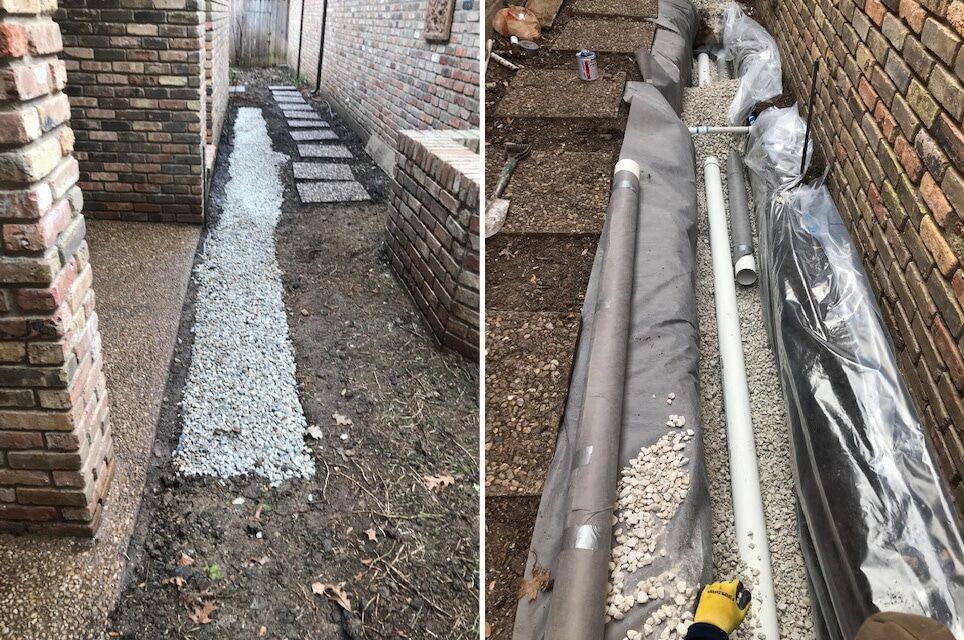Portland French Drain Myths Debunked by Drainage Experts
Portland French Drain Myths Debunked by Drainage Experts
Blog Article
The Crucial Guide to Preserving Your French Drain for Lasting Efficiency
Keeping your French drainpipe is key to its performance and your building's defense. Routine checks can conserve you from expensive fixings and water damages. You'll wish to know what indicators to seek and how typically to evaluate your system. Plus, understanding the cleansing procedure can make a considerable distinction. Let's discover the essential steps for ensuring your drainpipe operates well for years to come.
Recognizing the Function of a French Drain
A French drainpipe is an important part in managing water around your home. It directs excess water away from your structure, preventing flooding and damages. When heavy rain falls, the drain collects water with a perforated pipe hidden in crushed rock. This system permits water to stream openly, minimizing stress on your cellar wall surfaces and lessening the danger of leaks.You could question just how it operates in technique. As water fills the soil, gravity pulls it toward the drainpipe. The perforated pipe records this water, carrying it to an assigned drain area or tornado sewer. This procedure maintains your lawn completely dry and secures your home's architectural integrity.Understanding exactly how a French drain features is crucial to valuing its importance. By successfully channeling water away, it assists maintain a secure and completely dry living environment. Maintaining your French drain in leading condition assurances you prevent expensive repair services down the line.
Regular Examinations: What to Search for
When you're evaluating your French drainpipe, beginning by looking for any kind of clogs that could be blocking water circulation. Take notice of indications of surface disintegration around the drain, as this can indicate prospective issues. Normal evaluations will certainly assist keep your water drainage system working effectively.
Clogged Drain Assessment
How can you tell if your French drain is clogged? Initially, watch for water merging in your backyard, particularly after heavy rain. If you discover locations where water accumulates rather than draining pipes, that's a red flag. You should likewise check the drainpipe electrical outlet; if water isn't spurting as it should, there's most likely an obstruction. Pay attention for unusual gurgling sounds, which can suggest trapped air. In addition, inspect the drainpipe's surface area for any kind of greenery growth, as roots can infiltrate and block the system. Finally, if you scent moldy odors, it might indicate stationary water brought on by a blockage. Routinely reviewing these indications can aid you maintain your French drainpipe successfully and protect against costly repair work.
Surface Area Erosion Examine

Cleaning Your French Drain: Step-by-Step Guide
Cleaning your French drain is important for maintaining it working effectively. You'll require some specific devices and a clear process to ensure every little thing runs smoothly. Let's walk with the actions and suggestions for preserving your drainpipe properly.
Tools You'll Require
To tackle the task of cleaning your French drainpipe properly, you'll intend to gather a few vital tools. Initially, get a sturdy set of gloves to protect your hands from debris and sharp items. A tiny shovel or trowel will help you get rid of dirt or blockages around the drainpipe. For removing the inside, a plumbing technician's serpent or a high-pressure water nozzle can be extremely helpful. You'll likewise need a bucket for accumulating any type of debris you take out. Finally, having a garden hose pipe available will certainly make it much easier to wash out the drainpipe and guarantee it's streaming smoothly. With these devices prepared, you'll be established for a comprehensive cleansing session!
Cleaning Up Process Steps
Begin by reviewing the location around your French drain for any type of visible particles or obstructions. Remove fallen leaves, branches, or dust that might block water circulation. Next, examine the inlet and electrical outlet locations; clear any obstructions to assure proper water drainage. Make use of a garden hose to flush the drain, routing water into the inlet. This aids dislodge any built up sludge or debris. Think about using a plumbing technician's snake to damage them up if you notice consistent clogs. After cleaning, evaluate the gravel around the drainpipe; replenish it if it's gotten rid of. Confirm the drainpipe covers are intact and safely in area to avoid particles from entering. Regular cleansing maintains your French drain working effectively.
Maintenance Regularity Tips
While normal upkeep is necessary for your French drain's durability, recognizing how commonly to keep it can make all the distinction. Preferably, you ought to examine your French drainpipe a minimum of two times a year, ideally in springtime and fall. After heavy rains or snowmelt, look for obstructions or debris. If you notice any type of standing water, it's time to clean your drain.In areas with hefty vegetation, even more constant upkeep-- concerning every 3 months-- might be essential. In addition, think about cleansing your French drain after significant storms or if you observe water merging in your backyard. By staying proactive, you'll guarantee your French drainpipe functions efficiently and protects your residential or commercial property from water damage. Routine checks will certainly conserve you time and cash in the future.
Determining Typical Concerns and Their Solutions
When you observe water merging in your lawn or damp areas in your basement, it's crucial to determine typical issues with your French drain and carry out reliable services. One frequent problem is blocking, often brought on by debris like fallen leaves or sediment. To repair this, you can make use of a pipes snake or a high-pressure water jet to clear blockages.Another problem may be incorrect incline. Water won't move away from your home if your drainpipe isn't sloped correctly. You can readjust the incline by excavating and rearranging the drain pipe.Lastly, look for damage or splits in the drain itself. If you locate any kind of, changing the harmed areas is necessary for peak performance. By resolving these problems quickly, you'll help ensure that your French drain remains to work efficiently, protecting your building from water damage and maintaining a dry, secure atmosphere.
Seasonal Upkeep Tips for Your French Drain
Resolving common concerns with your French drain is just the initial step in assuring its long-term efficiency. Seasonal upkeep is important for peak efficiency. In the springtime, clear away leaves and particles that might have built up throughout winter. Inspect for any kind of blockages in the outlet or capture container, check this site out as water needs a additional resources clear path to move freely.During summer, check your drainpipe for any indications of settling or moving soil. Ensure it's still degree and working effectively. As fall techniques, clear out any fallen delegates protect against clogs before wintertime arrives.In winter months, watch for freezing temperatures. If you reside in a cool environment, make certain your drainpipe isn't in danger of freezing. Protecting subjected pipes can aid. Regular checks and timely maintenance can avoid expensive fixings and keep your French drain functioning effectively year-round. Remain proactive and enjoy comfort understanding your drain system remains in good condition!
When to Call in a Professional
Recognizing when to call in a professional can conserve you time and protect against more damages to your French drain. It's a clear indicator that your drainpipe may be obstructed or harmed if you discover persistent standing water in your backyard. Do not disregard strange smells, as they can suggest sewage back-up or decay, which requires prompt attention.If you discover that your drain isn't operating appropriately after attempts to clean or maintain it, it's time to reach out for professional assistance. In addition, if you're unsure concerning the underlying problems or do not have the needed tools, working with an expert can provide tranquility of mind.Finally, if your French drain is old or has actually experienced significant damage, professional analysis can figure out whether repair work or full replacement is required. Count on the specialists to guarantee your water drainage system works effectively for years to find.
Tips for Avoiding Future Water Drainage Problems
To maintain your French drainpipe functioning successfully, on a regular basis inspecting and preserving it can make all the distinction. Start by removing particles, leaves, and dirt from the surface area and drainpipe openings. This prevents obstructions that can bring about water backup. Examine the gravel around the drain; if it's compressed or deteriorated, consider adding fresh crushed rock to maintain suitable flow.Next, divert water far from your drainpipe by guaranteeing seamless gutters and downspouts are clear and guiding water a minimum of 3 feet away from your foundation. Consistently examine for any type of indicators of damage or sagging. If you observe concerns, address them immediately.Finally, think about mounting a catch or a filter basin to catch larger debris before it enters the drain. By staying positive with these ideas, you'll lessen the threat of future water drainage troubles and maintain your French drainpipe in leading form.
Regularly Asked Inquiries
The length of time Does a French Drainpipe Commonly Last?
A French drainpipe typically lasts around 30 to 40 years, depending on the products made use of and upkeep (Portland French Drain). navigate here If you stay on top of routine checks, you can prolong its life expectancy even further
Can I Install a French Drain Myself?
Yes, you can install a French drainpipe on your own if you have actually got the right tools and knowledge. Just ensure to intend meticulously, adhere to regional laws, and assurance correct water drainage to prevent future problems.
What Materials Are Used in a French Drain?
You'll require perforated pipeline, gravel, landscape textile, and a strong drainage pipe for your French drainpipe. These materials assist reroute water successfully, protecting against flooding and keeping your home completely dry and risk-free from water damages.

Is a License Required to Mount a French Drain?
You'll likely require a license to set up a French drain, depending on local regulations. Get in touch with your town to guarantee you adhere to any essential guidelines and stay clear of possible concerns throughout installation.
What Are the Costs Associated With French Drainpipe Upkeep?
Maintaining a French drainpipe commonly sets you back between $100 and $500 every year. You'll need to take into consideration expenses for cleaning, repairs, and evaluations. Regular upkeep assists avoid larger expenditures and warranties your system functions effectively for several years - Portland French Drain. When you're checking your French drain, begin by checking for any kind of blockages that might be blocking water flow. By staying aggressive, you'll ensure your French drainpipe features effectively and shields your property from water damages. When you discover water pooling in your lawn or damp areas in your cellar, it's crucial to recognize usual issues with your French drain and execute efficient remedies. You can readjust the slope by digging and repositioning the drain pipe.Lastly, check for damage or fractures in the drainpipe itself. Examine the gravel around the drainpipe; if it's compacted or eroded, take into consideration including fresh gravel to preserve optimal flow.Next, divert water away from your drainpipe by making certain seamless gutters and downspouts are clear and routing water at least 3 feet away from your structure
Report this page